Home > Products > LAPEROS(R) LCP
Development of LAPEROS(R) LCP with superior blistering resistance
Development of LAPEROS® LCP with superior blistering resistance |
|---|
| Introduction |
Liquid crystal polymer (LCP) is the collective term for thermoplastic, aromatic polyester that exhibits a crystalline nature when melting. LCP is rigid polymer, with a molecular structure that is hard to bend. It has very few of the molecular entanglements that are typical of high polymers. Since LCP has a rigid molecular framework, its molecules become oriented in the direction of the flow with the application of only small amounts of shearing force, and it exhibits little flow resistance and high flowability during injection molding. When LCP solidifies, it maintains its structure as-is during melting. This produces the effect of little volume variation due to molecular realignment, while boasting high dimensional accuracy. LCP also offers other major advantages such as less frequent mold maintenance since it generates little gas during molding, and quick solidification that makes it well-suited to high-cycle molding. In addition to high flowability and dimensional accuracy, LCP also exhibits high heat resistance and is widely used in the market for connectors in devices such as smartphones which are becoming more compact and trending toward surface mount technology (SMT). The automotive, home electronics, and office automation industries are also increasingly considering and implementing LCP in recent years due to demand for high dimensional accuracy and heat resistance. While striving to improve the performance and quality of LAPEROS® LCP, Polyplastics has also been advancing research on molding processes that make full use of this performance. In this passage we will share our most up-to-date insight on blistering. |
| 1. Blistering in LCP, and its causes | |
One common flaw noticed in the market when using LCP is blistering. As shown in Figure 1, blistering is the phenomenon in which bulges appear on the surface of molded articles due to heat. |
 |
Figure 1 : Blistering on the surface of a molded article (left), |
|---|
Since LCP is used in lots of surface-mount electronic components, blistering in the form of bulges on the surface of products after a heating reflow is a major problem. As shown in Figure 2, blistering has a variety of potential causes including LCP decomposition gases, gases that get entrapped during molding, and separation between the skin and core layers. Measures must be taken according to the cause. |
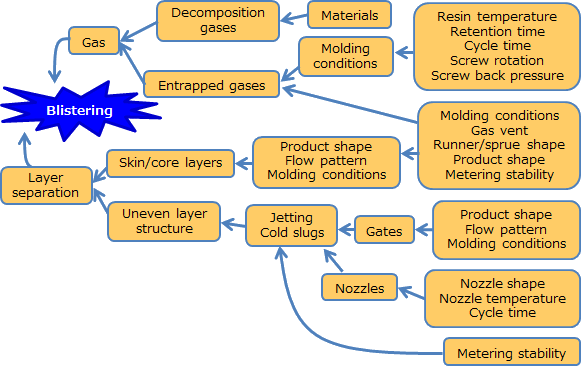 |
Figure 2 : Classifications of typical causes of blistering in LCP |
|---|
In terms of materials, it is important to use those with higher heat stability, which also generate little gas. LAPEROS comes in a wide-ranging lineup of grades to accommodate customer needs, including ultra-high heat resistant grades. Additionally, other factors such as molding conditions and mold shape design also have a strong influence on blistering occurrence. Figure 3 shows combinations of nozzles and sprues. Among these combinations, we see that when the difference between the diameters of the nozzle and sprue is large and injection speed is fast, coil-shaped jetting will occur as shown in the photo on the right in Figure 3. Jetting destabilizes the layer structure of LCP molded articles and makes blistering resistance worse. Table 1 shows the injection speed dependence for the frequency of blistering occurrence in each sprue diameter. We see that while blistering does not occur in the slim 3mm-diameter sprue under high-speed molding conditions of 300mm/s, blistering does occur at 100mm/s with a 7mm-diameter sprue. Therefore, an optimal sprue diameter will make it possible to select from among a wider range of molding conditions and allow for more stability in molding. |
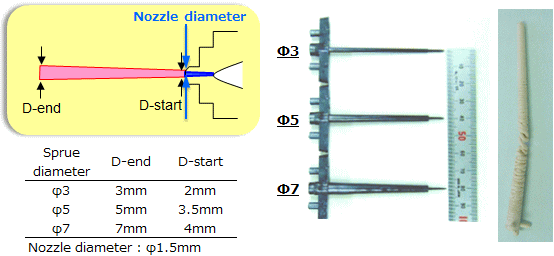 |
Figure 3 : Examples of sprue designs in LCP molding |
|---|
Table 1 : Injection speed dependence for the rate of blistering |
Materials |
Sprue diameter |
Injection speed (mm/s) |
|||||
50 |
100 |
150 |
200 |
250 |
300 |
||
LAPEROS® E471i |
φ3 | 0 | 0 | 0 | 0 | 0 | 0 |
| φ5 | 0 | 0 | 0 | 0 | 80 | ||
| φ7 | 0 | 100 | |||||
|
Nozzle diameter: 1.5mm | Unit: % |
| 2. Blistering formation due to changes in wall thickness, and how to evaluate it |
As mentioned above, Polyplastics has developed high heat resistant grades and conducted studies on nozzle and sprue optimization with the aim of offering solutions to the market for problems with blistering. However, the market is still not completely free from problems related to blistering. Figure 4 shows a DDR connector, which is a typical example of an item that uses LCP. Many connectors are made thinner (reducing product thickness) with the goal of reducing their weight. We know that blistering is prone to occur in the thicker parts of molded articles with uneven thickness such as this one, and the tendency varies greatly depending on the shape, molding conditions, and materials. Here, Polyplastics focused on changes in the wall thickness of molded articles, designed a mold, and conducted an evaluation as shown in Figure 5. The changes in wall thickness (step height) from the thinner to the thicker parts of this mold can be made arbitrarily, and the dependence on molding conditions and differences in tendencies due to the materials can be evaluated. |
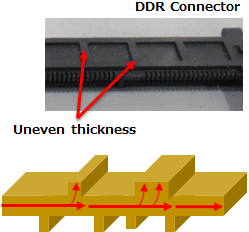 |
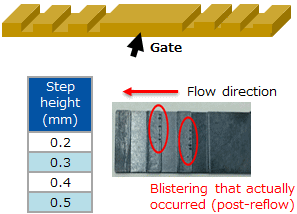 |
Figure 4 : DDR connector |
Figure 5 : Polyplastics molded articles used for evaluation |
|---|
Table 2 shows the results of post-reflow blistering evaluations for molded articles using the Polyplastics mold. Both LAPEROS grades E463i and E473i tend to form blisters more easily as injection speed and step height increase. However, there is a big difference between these two grades in how easily blistering occurs. E463i experiences no blistering even at step height of 0.4mm and injection speed of 300mm/s, while E473i starts to form blisters even at relatively low 0.3mm step height and 200mm/s injection speed. Since blistering tendency differs so greatly even with the same shape and molding conditions, it is important to know these characteristics when choosing a grade. |
Table 2 : Post-reflow blistering occurrence rate for each step height |
| LAPEROS® LCP 463i | LAPEROS® LCP E473i | ||||||||||||||||||||||||||||||||||||||||||||||||||||||||||||||
|
|
||||||||||||||||||||||||||||||||||||||||||||||||||||||||||||||
Figure 6 shows how filling proceeds in the part with the step. With materials that do not easily form blisters, resin fills the cavity according to its shape even in the part where the flow expands due to the step, and responsiveness to shape change can be considered high. On the other hand, when we look at materials that form blisters more easily, we see that resin does not sufficiently spread out in parts where the flow expands, as it continues flowing onward in a straight line. When resin flows in a straight line it fills the part with the step in a delayed manner, and only fills this part after some resin has already flowed to other cavities. As we can see in Figure 7, the material that easily forms blisters still has a gap in the step part even in the final stage of filling. Ultimately this gap will likely form an unstable surface when resin filling is complete. Unstable surfaces easily separate and form blisters due to heat processing. |
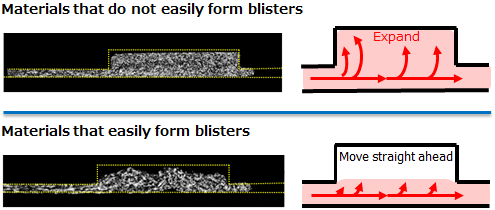 |
Figure 6 : Filling movement in the step part |
|---|
 |
Figure 7 : Filling in the step part with materials that form blisters easily |
|---|
| 3. LAPEROS® LCP materials developed to inhibit blistering |
The swelling properties of materials have a major influence on the size of flow expansion, which decides whether unstable surfaces will be formed in the part with the step. We know that swelling characteristics differ greatly according to the type of polymer and filler, and this point should be taken into consideration when choosing grades. Based on this knowledge, Polyplastics has developed grades that inhibit blistering in parts where wall thickness suddenly changes. Table 3 shows the properties of two types of materials developed to have superior blistering resistance. Both of these materials have been confirmed to inhibit blistering much more effectively than existing materials, and they show strong potential for improving productivity. Sampling these developed materials even more, Polyplastics will be working to achieve an even greater reduction in blistering defects. |
Table 3 : Properties of LAPEROS® LCP with superior blistering resistance |
Item |
Testing |
Units |
Developed |
Developed |
E463i |
E473i |
Low warpage |
Low warpage |
Low warpage |
Low warpage |
|||
Melt viscosity |
ISO 11443 | Pa.s | 41 | 34 | 40 | 25 |
Bending strength |
ISO 178 | MPa | 160 | 140 | 130 | 160 |
Flexural modulus |
ISO 178 | MPa | 12,100 | 11,000 | 10,600 | 11,000 |
Bending fracture strain |
ISO 178 | % | 3.1 | 3.5 | 3.1 | 2.8 |
DTUL (1.82MPa) |
ISO 75-1,2 | ℃ | 246 | 243 | 235 | 250 |
Blistering rate |
Polyplastics method |
% | 2 | <1 | 9 | 54 |
| Conclusion |
As described above, you need to choose the right grades and molding process in order to make full use of the benefits that LAPEROS® LCP has to offer. Here we have shared knowledge that Polyplastics possesses about blistering that occurs in the step parts of molded articles, but blistering defects have a broad range of potential causes. Therefore, the most important thing is to have an accurate understanding of what blistering really is. Polyplastics offers high quality resin materials that are even easier to mold, while providing the proper advice and support for molding processes. |
[Related information] • Using CAE to Forecast Deformation During the Reflow Process |
Technical data sheet is available online: |
|
||||
For inquiries about our technologies |
◆Polyplastics Group Representative | ||||
| ◆WEB Inquiry |
26th November 2019 |

